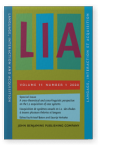Introduction published In:
A cross-theoretical and cross-linguistic perspective on the L2 acquisition of case systems / L'acquisition de systèmes casuels en L2 : des études à travers plusieurs théories et languesEdited by Kristof Baten and Saartje Verbeke
[Language, Interaction and Acquisition 11:1] 2020
► pp. 19–31
